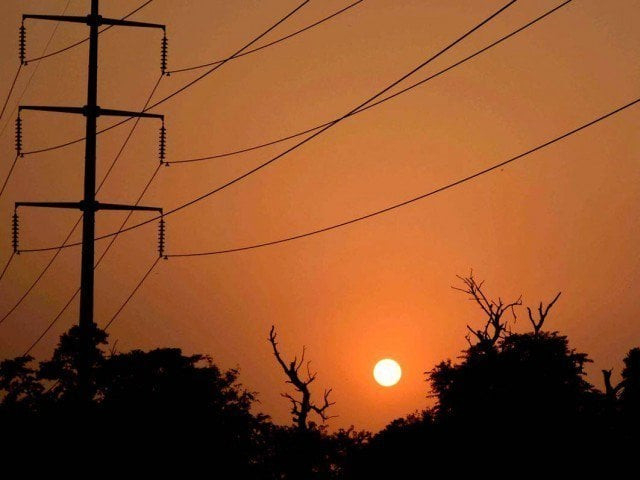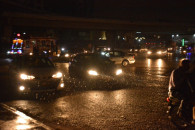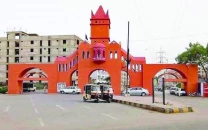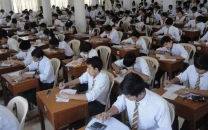People suffer from prolonged power cuts amid hot weather in Karachi
Load shedding hours rose drastically after Eid, peaking to 12 hours every day

PHOTO: APP/FILE
Despite its tall claims and promises, KE administration failed to ensure uninterrupted supply of electricity in Karachi, plunging the city into darkness and forcing the citizens to suffer in scorching heat. As Karachiites continue to suffer from unbearable heat, KE’s claim that 60% of the localities in Karachi are exempted from load shedding seemed baseless.
Prolonged spells of load shedding were experienced in different areas of the city, including Korangi, Landhi, DHA, Clifton, Lyari, Maripur, Kemari, Sultanabad, Hijrat Colony, Shirin Jinnah Colony, North Karachi, Gulzar Hijri, Liaquatabad, Orangi Town, Nazimabad, North Nazimabad, Gulsan-e-Iqbal, Gulistan-e-Johar, Malir and Quaidabad.
Load shedding hours in Karachi rose drastically after Eid. With the maximum duration of load shedding peaking to 8 to 12 hours every day, mostly in densely populated areas of Karachi, citizens complain that they hadn’t been informed of the extension in load shedding hours by KE prior to this development. Additionally, numerous localities in the city experience two to four hours of load shedding at least thrice a day.
Karachi has become ‘worst city’ in country: SC
According to sources at KE, hot weather has affected the power distribution across the city badly. The frequency of technical faults disrupting electricity supply has increased manifolds and the company has been receiving several complaints in this regard on a daily basis.
Citizens complained that they have been trying to reach KE officials through 118 helpline and social media platforms, but the officials fail to assist them. In most cases, they are given the response that power supply in their area is affected due to a technical fault, which is a reply too brief and does little to help their purpose, complained the citizens.
Reportedly, KE has not been able to generate enough power to meet the demand of the entire city, despite utilising all of its resources. Instead, it solely depends on electricity produced by natural gas powerhouses and 600 megawatts of electricity generated by WAPDA to meet the demand for electricity in Karachi. It is has also been reported that KE has limited the generation of electricity through furnace oil sourcing of electricity from private furnace oil powerhouses, in order to cut down on expenditure.
A recent example of KE’s ineptness was witnessed when many areas of the city, including Karachi University Employees Society Scheme 33, Nazimabad No 2, North Karachi, New Karachi, Surjani Town, Malir and Korangi, experienced hours-long load shedding on Wednesday night.
Residents of Karachi University Employees Society scheme 33 called The Express Tribune and informed that there was no electricity in the area since 2am on Wednesday night, and the supply hadn’t been restored until 7am on Thursday morning.
Residents of the area complained that relevant KE officials were informed of the issue and a complaint was also lodged at the complaint cell but to action was taken to resolve the issue. They maintained that the officials failed to give them an assuring response.
According to the residents, unannounced load shedding had begun before Eid and they had to bear long hours of power outages even in Ramazan, while KE officials kept on claiming that no load shedding was conducted in the city during the holy month.
A KE spokesperson however claimed that reduction in gas pressure has affected that generation capacity of some of KE’s power plants. This, coupled with the increase in demand for electricity during summer, has resulted in temporary interruption in electricity supply to some areas of the city, he said.
He further said that KE’s teams have been working round the clock to ensure timely restoration of power supply, adding that there have been no reports of extended power outages from any part of the city. He also claimed that the duration of load shedding has not been extended.
Meanwhile, Sui Southern Gas Company (SSGC) has refuted KE’s claims that load shedding in the city is a consequence of low gas pressure.
According to SSGC representative, KE’s daily requirement of gas is about 190mmcfd but it is being supplied with additional 10 to 15mmcfd, so that the citizens of Karachi are provided with some relief in the hot weather. He further said that KE had been supplied with 199mmcfd of gas three days before and it is being supplied with 194mmcfd of gas since Wednesday. In this manner, on average 210mmcfd of gas is supplied to various plants of KE in a month, he added.
He said that not only is KE being supplied with gas in excess of its demand but the gas is supplied on full pressure.
Karachi bakes after Cyclone Vayu cuts off city’s sea breeze
Water crisis persists in the city
Amid rising temperature, demand for water has also peaked in Karachi. As a result, the city now faces a water crisis, which is further aggravated by KE’s inefficiency.
Water supply to various areas of the city, from local pumping stations, is severely affected due to hours-long power outages, leaving its residents deprived of the basic commodity. According to sources at Karachi Water and Sewerage Board, water supply to the city is disrupted due to prolonged power outages.
The demand for water in Karachi has increased to 1.2 billion gallons, while KWSB is only able to supply up to 550 million gallons of water to the city. As a result, the city faces a shortfall of 650 million gallons of water.
Presently, there are 300 local pumping stations in the city from which water supply mostly remains suspended due to load shedding and so far, no step has been taken by the Sindh Government to resolve the issue.
Besides, another reason for the prevalent water crisis is the unfair distribution of water.
In Karachi, areas that are severely affected by water shortage include Korangi, Landhi, North Karachi, Nazimabad, Lines Area, Surjani Town, Baldia Town, Orangi Town, Mehmoodabad and Manzoor Colony.
Published in The Express Tribune, June 14th, 2019.


















COMMENTS
Comments are moderated and generally will be posted if they are on-topic and not abusive.
For more information, please see our Comments FAQ